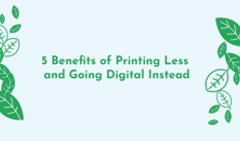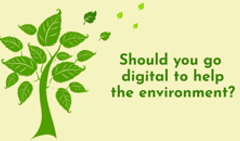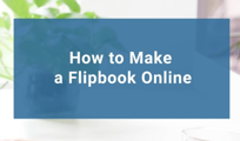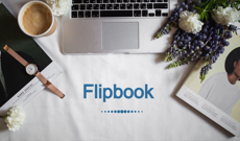If you’re doing it seriously, content creation is costly in and of itself, every magazine, catalog, or brochure being a product of the combined effort of authors, copywriters, designers, editors, etc. But no matter what industry your business belongs to, the cost of creating content doesn’t even come close to the expenses of printing and shipping.
How to cut costs on content distribution without losing the perks and looks of printed publications? In this article, we’re going to argue that digital flipbooks are the answer.
Traditional Distribution
Even in this day and age, a lot of types of content are still largely distributed via print. Sometimes, it’s just the way an industry operates—for example, insurance companies tend to print and ship benefit guides to their clients and potential customers rather than send them digitally. Sometimes, a digital solution has already been tried by a company but didn’t prove to be as effective as they hoped, or couldn’t provide a tantamount substitute to printing in its visual presentation, ease of use, or ease of distribution. As a result, the high cost of printing and shipping is tolerated by some as a necessary evil—but it shouldn’t be.
How Digital Flipbooks Can Help You Save On Distribution
A digital flipbook is an HTML5 publication converted from a PDF via a flipbook-making solution, such as FlippingBook. Digital flipbooks provide a lot of handy perks for publishing online: content protection, ease of update, built-in statistics, and so on. Any of these features can become the deciding factor in going digital, depending on your needs. Compared to other digital document solutions, such as PDF or PowerPoint presentations, flipbooks also win the game of aesthetics as they look just like printed publications with their smooth and realistic page turn effect. But what’s more important, digital flipbooks reduce content distribution costs tremendously, just by being so easy to share.
Flipbooks saved us thousands of dollars in printing.
Kyle Todt from The Royal College of Dentists of Canada
Read on to learn how you can save money on distribution of different types of content.
#1 Sales Catalogs
Turned into digital flipbooks, your sales catalogs can be updated and sent out to all your sales reps and dealers simultaneously. Your salespeople will be happy to have the most up-to-date sales collateral at their fingertips without having to carry around massive catalogs with samples and notes, and you won’t have to worry about printing, reprinting, or shipping costs ever again.
#2 Marketing Collateral
Paper catalogs become redundant when you can embed your online catalog right into your website for visitors to flip through without leaving the page, post it on social media, or place its QR code in your showroom for quick and safe touch-free access.
Concrete Collaborative Catalog
Create yours
#3 Brochures and Flyers
The lifespan of a flyer is very short, and then the document goes to waste, and you won’t ever know if the money you spent on printing it out has paid off. However, if your flyer or a brochure is an online flipbook, not only do you save on printing and help the environment by minimizing paper waste, but you can also track the effectiveness of every marketing brochure you emailed or shared on social media, so you know exactly what content or marketing channels to invest in.
#4 Handbooks
Handbooks are created to make life easier but if you print them? Not so much. For you, it’s the aforementioned cost of printing; for your students or employees—a format that’s not really that convenient to use. A handbook is supposed to be something you can always turn to if you need guidance or clarification but hardly anyone will bother to carry around its printed version. Digital flipbooks, however, are mobile-friendly and easy to flip through, with several top-notch navigation features that ensure you’ll find anything you need in seconds. This way, you save money for yourself and time for your readers.
#5 Product Manuals
Same as with handbooks, product manuals are supposed to be an easy source of information for a customer, yet in their printed format the primary thing they offer is a poor user experience. Remember that printed product manual that came with a toaster or a blow dryer? Tiny, barely readable text; black-and-white pictures; and 17 other languages to flip through… Wouldn’t it be so much easier for everyone if a customer could just scan a QR code on the package of their device and open a digital manual—colorful, interactive, and easy to navigate? As a manufacturer, you would be able to make your manual as detailed as you want, adding links, videos, and pop-up images for a better user experience. And just imagine how many trees will be saved if more product manuals are turned digital!
#6 Benefit Guides
In an environment where benefits guides have to stay relevant for a whole year and any change in an insurance policy demands a swift update, you have to get used to paying for reprints, constantly. Or—just switch to digital flipbooks. If your benefits guide is digital, you can customize, update, or resend it all you want, without any extra cost, ever. And if you make it interactive with videos, links, GIFs, and such? It will certainly make you stand out amongst your competitors who still stick to paper.
#7 Magazines
Traditional publishing is tough, yet self-publishing is even tougher in some ways because you have to give your own money to find the perfect tool and get your word out there. And we’re used to the idea that perfection costs: if you want your magazine to be printed out on fine glossy paper, it will be expensive. If you want it to look really professional, it will cost. But digital flipbooks make all of this a bit easier—and cheaper. When published online as a flipbook, your magazine looks awesome already, without any extra printing costs. You can even highlight its content with a matching background or add multimedia on its pages. And you always know what your readers have found especially engaging just by looking at the stats, thus saving your time and money in the future.
And So On
Think about the documents you use daily or often enough whose distribution still costs you a fortune. Maybe, you can save considerably just by switching to the digital flipbook format, too.
Turn your PDF into a flipbook and try it out now
Try for free





